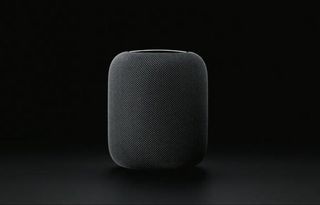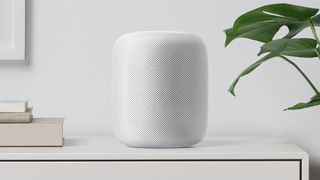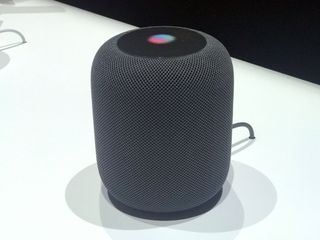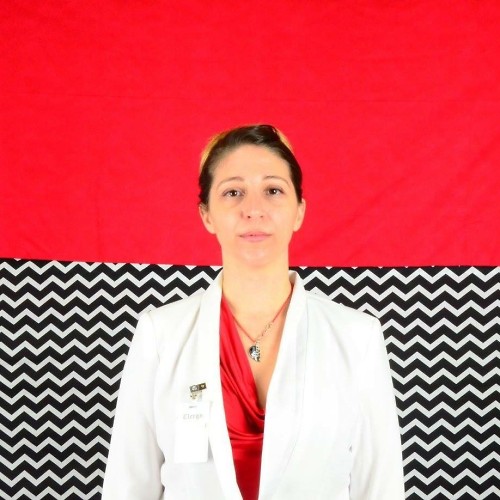HomePod: Everything you need to know

Apple's highly anticipated HomePod is now available! The Wi-Fi connected speaker offers up Siri voice control, HomeKit functionality, and boasts incredible, virtual surround sound. Wanna know more? We've got the details!
September 12, 2018: HomePod OS has been updated with new features and Siri languages
Today as part of Apple's 2018 keynote event in Cupertino, CA, the company announced in a press release that a few new incredible features are coming to HomePod OS. With support for multiple timers, making and taking phone calls, and more, the upgrade makes HomePod more versatile than ever before.
Here's what you can expect from the update, according to Apple:
- New Siri languages: HomePod now offers support for Spanish in the US, Spain, and Mexico, as well as support for Canadian French in Canada.
- Make and receive phone calls: HomePod users can now make and receive phone calls directly from their spart speaker. To make a call, all you have to do ask Siri to call someone from Contacts or say the number you'd like to reach aloud. Receiving a call is even easier: because incoming calls are automatically directed from iPhone to HomePod, all you need to do is ask Siri to answer the phone. You can also review missed calls and transfer a call between your HomePod and your iPhone.
- Search by lyrics: Now, in addition to asking Siri to play a particular song or artist, you can ask it to "play the song that goes like this..." and recite the lyrics. It's a great tool for the scatterbrained among us who are better at remembering lyrics than song names.
- Multiple timers: Busy individuals, this one's for you. HomePod now supports multiple named timers so you can keep track of all your timed tasks using your voice alone.
- Find My iPhone: Find My iPhone has officially come to HomePod, allowing you to ping any of their nearby devices from your speaker to locate them. Siri Shortcuts: You can now use the ultra-cool Siri Shortcuts on HomePod just as you can on iPhone and iPad, meaning a simple good morning greeting to Siri can turn on your lights, share your appointments with you, and order your usual from your coffee shop of choice.
Best of all, because Apple isn't a company that charges for its software upgrades anymore, this HomePod OS update will be free for all HomePod users beginning Sept. 17 with the launch of iOS 12.
May 29, 2018: HomePod coming to Canada, France, and Germany on June 18
Apple has announced that HomePod will become available in Canada, France, and Germany on June 18. This news comes as Apple also announces that iOS 11.4 will bring stereo pairing and AirPlay 2 multi-room audio support to HomePod.
While pricing for France and Germany hasn't been announced yet, we do know that HomePod will sell in Canada for $449 (CAD).
January 23, 2018: HomePod arrives February 9, available to order this Friday
From Apple:
Master your iPhone in minutes
iMore offers spot-on advice and guidance from our team of experts, with decades of Apple device experience to lean on. Learn more with iMore!
HomePod, the innovative wireless speaker from Apple, arrives in stores beginning Friday, February 9 and is available to order online this Friday, January 26 in the US, UK and Australia. HomePod will arrive in France and Germany this spring.
In what some are calling the great iOS 11 developer beta leak of 2017, we now have some details on how you'll set up your HomePod when it arrives February 9, at least as the implementation stands right now. Setting up the HomePod will require some sort of connection to your iOS device, and the setup files, first spotted by iHelp BR, indicate that at least part of the process will be similar to the setup for AirPods and other W1-equipped headphones, though the HomePod itself doesn't seem to have a W1 chip.
Text translated from Portuguese:
According to some images that we find in the internal files of the system, the pairing of the HomePod (codenamed B238) will be very similar to the AirPods wireless headphones. When you turn on the speaker for the first time, iOS will ask the user if they want to perform the setup with that iPhone, iPad, or iPod touch. It will not be possible to set up a HomePod for Mac or Apple TV - although it is very likely that the device will work normally with them later.
Developer Guilherme Rambo has delved a little deeper into the files, providing video of the process, showing how the same method will apparently be used across the HomePod, whole home audio, and the Apple TV.
This is how the HomePod setup will look like on an iPhone. pic.twitter.com/SARqsYslL6This is how the HomePod setup will look like on an iPhone. pic.twitter.com/SARqsYslL6— Guilherme Rambo (@_inside) August 22, 2017August 22, 2017
The same setup method will be adopted for Apple TV. pic.twitter.com/UcYg4bvFwaThe same setup method will be adopted for Apple TV. pic.twitter.com/UcYg4bvFwa— Guilherme Rambo (@_inside) August 22, 2017August 22, 2017
Same for Whole House Audio pic.twitter.com/ZZSIrO3mUASame for Whole House Audio pic.twitter.com/ZZSIrO3mUA— Guilherme Rambo (@_inside) August 22, 2017August 22, 2017
So what exactly is a 'HomePod'?

To generalize, it's Apple's answer to the Amazon Echo line of speakers. It's a dedicated speaker that supports Siri for access to Apple Music and HomeKit-enabled devices.
To be more specific, it's one hell of a sound system packed into a 7-inch tall package. It has a specially engineered audio design to produce quality sound throughout your entire room, even if it's set up in a corner.
Thanks to AirPlay 2 support you can connect it to HomePods all over the house and even control other AirPlay 2 supported speakers with it.
It's built with Siri inside, so you can use it to play tunes through Apple Music, send messages, make phone calls, and control your HomeKit enabled devices.
Sounds cool. Tell me more?
Mobile Nations Editorial Director, Rene Ritchie, describes listening to HomePod as "Retina for your ears." It's packed with a six-microphone array, a seven-tweeter beam-forming array, a high-excursion woofer with a customized amplifier, a 20 mm diaphragm and an advanced algorithm that constantly analyzes the music being played and adjusts the levels to make sure that the sound output is exactly right.
It's built with Apple's A8 system-on-a-chip so that streaming music is as fast and smooth as possible. The microphones are directional so you can be heard over the music when you need Siri to do something. The specially designed speaker is equipped with spatial awareness to provide the best sound, no matter where the HomePod is set up.
Spatial awareness? What's that?
To put it simply, HomePod is "aware" of your room's layout and adjusts it's audio output accordingly. If you're HomePod is in the center of the room, you'll hear everything from everywhere.
If it's only a few feet from a wall on one side, it adjusts the sound and separates the music into direct (the speakers that face out), and ambient (the speakers that are close to the wall) beams. It's pretty cool.
So I can use Siri with it?

That's right. HomePod runs on Siri, sort of the same way that Alexa runs on Echo. You can use it to play Apple Music, make and receive calls and messages, and control HomeKit-enabled devices.
Apple boasts Siri on HomePod's abilities as a "musicologist." When you play tunes from Apple Music, you can tell Siri what you do and don't like and it will start to suggest songs based on your listening history. This data will also be transferred to your iPhone and iPad so your listening preferences are set across all of your devices.
If you've got HomeKit-compatible smart home gadgets, Siri in HomePod cancontrol them exactly the same way that Siri controls them from your iPhone and iPad. Even your scenes can be triggered through the HomePod. Lock down your home and turn off the lights before bed and tell Siri to set the "Good night" scene on HomePod.
You can use HomePod to send messages using your voice. If you receive a message, you can have Siri read it back to you through HomePod. If you want to call someone or answer a call from your HomePod, have Siri take care of the Handoff. It also works to set reminders, create lists, and more.
Siri is also a general know-it-all on HomePod. You can ask it questions about sports, weather, traffic conditions, and more. Use HomePod to set timers, translate languages, and tell you how many ounces are in a quart.
Can everyone in my family use Siri on HomePod?
That's something we're not totally clear on at this time. HomePod is Siri-supported, but there is no official information about whether anyone in the house can use it.
HomePod uses peer-to-peer Airplay to allow your visiting friends to use your HomePod without having to connect to wifi. However, it appears that most of Siri's iCloud functions will be relegated to one device/account user.
According to Rene Ritchie, it's a privacy thing.
Apple being Apple, the company has also built the HomePod to prioritize privacy: The device listens for "Hey Siri," yes, but that command word is processed entirely locally on the device — no data is sent to Apple unless and until you speak the magic words. Even then, HomePod only sends anonymized data; it's one of the benefits of a company that doesn't make data harvesting its central business model.
Can I use it as a Bluetooth speaker?

Sorry, no. HomePod is equipped with AirPlay 2 compatibility. The good news is that your iPhone, iPad, Mac, and any device with AirPlay support works perfectly with HomePod. The bad news is that you can't connect it directly to your Bluetooth devices, like a T.V. set, game console, or Android device. Though HomePod does have Bluetooth 5.0, it's not currently capable of streaming audio from Bluetooth devices.
Hopefully, Apple will add that functionality, and soon!
Will my iPhone work with it?
Probably. HomePod support goes back all the way to iPhone 5s, 5th-generation iPad, iPad mini 2, first-generation iPad Air, and all sizes of iPad Pro. It also supports the sixth-generation iPod Touch.
Your iOS device must be running on iOS 11.2.5 or later, so if you haven't updated yet, you might as well get that going if you want a HomePod.
Is it wireless?
Though the HomePod is a svelte 7-inches tall, it's way too powerful to use a portable battery. No. This bad boy needs direct power from an outlet.
What color does it come in?

HomePod is covered in an attractive mesh fabric designed to look good and resonate well, acoustically (think about the mesh-covered front of a guitar amp). You can get it in white or space gray.
Sorry, no rose gold or (Product)Red. Though, it's possible that we'll see an exclusive version of the latter at some point in the future.
OK, I'm in. How much does it cost?
A single HomePod costs $349. If you're hoping to outfit your entire house with a HomePod system, you can get a few of them and use AirPlay 2 to daisy chain them together. You can play them in stereo or play different audio from different speakers throughout the house (though daisy chaining may not be available right at launch).
When can I get one?
You can pre-order the HomePod on January 26. It'll be available in-stores or delivered to your door on February 9.
Any more questions?
Do you have any more questions about HomePod? Let us know in the comments!
Lory is a renaissance woman, writing news, reviews, and how-to guides for iMore. She also fancies herself a bit of a rock star in her town and spends too much time reading comic books. If she's not typing away at her keyboard, you can probably find her at Disneyland or watching Star Wars (or both).
Most Popular






